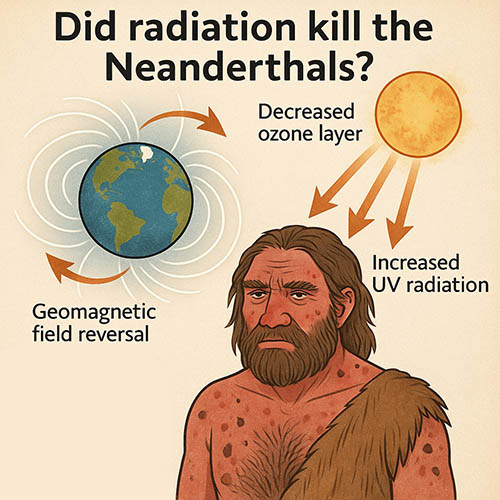Did radiation kill the Neanderthals?
So, Dr. Z – I saw something in my feed about radiation killing the Neanderthals. Really? How can they know this? And could it have – really?
Well…maybe…and maybe not. I have to admit to being dubious on this one, but let’s see what the research claims and whether or not it seems to hold water.
What the authors of this paper are postulating is that, during a geomagnetic field reversal, the terrestrial magnetic field faded a bit, that this led to the destruction of much of our protective ozone layer, and that Neanderthals (whose seem to have worn animal skins instead of more-tailored clothing and who might not have used mineral pigments to decorate themselves) died off from an epidemic of skin (and possibly other) cancer.
Here’s the thing, though. The authors of this article base a large part of their argument on a 30-year-old paper that suggests that the ozone layer weakens slightly when our magnetic field weakens a tad and that, therefore, during a magnetic field excursion (a more significant weakening) the ozone depletion must be even more significantly reduced – and that this greater reduction might be large enough to have health effects…enough to contribute to the extinction of the Neanderthals.
I remember talking with my MS advisor when I was first starting my research – he said “Remember – if you conclude that life can’t exist, well, we have evidence to the contrary.” And with this hypothesis, well, we have ample evidence that more significant and longer-lasting reductions in Earth’s magnetic field strength have not led to large-scale extinctions, even of organisms likely to be most susceptible to increased UV and cosmic radiation levels. Thus, the authors’ conclusion that a relatively short-term reduction in Earth’s magnetic field strength could have had a significant impact on one species seems dubious. I should add that the authors also suggest that the extinction of much of the Earth’s megafauna was linked to this event, but that is also a bit of an overreach – partly because the animals that became extinct had fur, which would have given protection from UV radiation and partly because the megafauna extinctions seem fairly conclusively linked to hunting due to the migration of humans into those areas.
In fact, the Earth’s magnetic field has reversed dozens of times over the history of life on Earth, and that these reversals aren’t reflected by mass levels of extinctions in the fossil record. This, too, suggests that magnetic field reversals aren’t linked to mass extinctions, making it even more unlikely that the combination of a magnetic field excursion coupled with Neanderthal garb and makeup is an unlikely cause for their extinction. Having said that, the authors also propose that increased auroral activity at lower geomagnetic latitudes (which can be expected to happen during such an event) might have helped spark some of the cultural (including artistic) changes seen around the same time as this magnetic excursion.
To me, this work smacks of a common tendency among those who don’t know much about the actual biological effects of radiation exposure – there is a tendency to focus so much on the relatively small risk from radiation that consideration of all else falls by the wayside.
